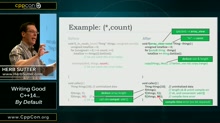Covariance with Smart Pointers--Arne Mertz
A not so easy problem:
Covariance with Smart Pointers
by Arne Mertz
From the article:
Covariance can be a useful concept, e.g. when implementing the abstract factory design pattern. However, in modern C++, we should return smart pointers that are not recognized to be covariant like raw pointers by the compiler...

 Have you registered for CppCon 2016 in September? Don’t delay –
Have you registered for CppCon 2016 in September? Don’t delay –  Have you registered for CppCon 2016 in September? Don’t delay –
Have you registered for CppCon 2016 in September? Don’t delay –